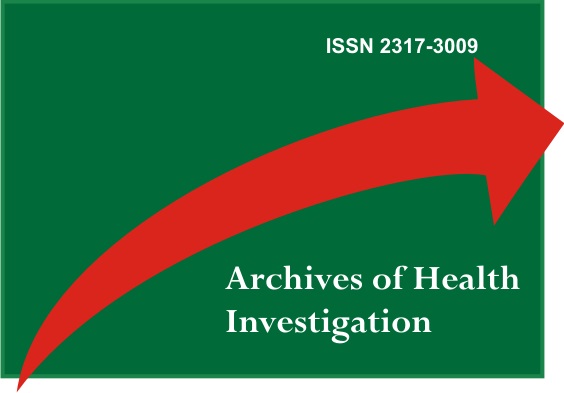Radial Nerve Injuries in Humeral Shaft Fractures: Experience of a Tertiary Hospital
DOI:
https://doi.org/10.21270/archi.v12i9.6253Keywords:
Humeral Fractures, Radial Nerve, Peripheral NervesAbstract
Background: The statistically relevant association of humeral diaphyseal fracture and radial nerve injury, mainly due to the anatomical path of this nerve is still one of the main factors of discussion nowadays since it is not a lesion with high incidence, which does not have a established and accepted protocols for its management. This, consequently, results in a spectrum of functional outcomes for patients who present with radial nerve injury associated with diaphyseal fracture. Objective: This study aimed to evaluate the patients treated in our emergency service with humeral diaphyseal fracture and associated radial nerve injury. Methods: A retrospective study based on the review of medical records that analyzed all patients who were seen in our emergency unit from January 2015 to July 2022 and who had a humeral diaphyseal fracture associated with radial nerve injury. Evaluating the patient's variables, inherent to trauma and fracture personality, association with radial nerve injury, and subsequent management. Thus, 80 patients were eligible for this study, 23 women and 57 men. Results: There was no statistical difference between Radial Nerve Injury and AO Classification (p=0.188; Chi-Square test), trauma mechanism (p=0.832; Chi-Square test), postoperative complications (p=0.087; Chi-Square test), gender (p=0.288; Chi-Square test), surgical re-approach (p=0.264; Chi-Square test), use of the implant chosen for definitive osteosynthesis (p=0.684; Chi-square test) and open fracture (p=0.100; Chi-square test). However, we observed a statistical difference in the use of external fixators (p=0.008; Chi-square test). Conclusion: Neuropraxia occurs by the mechanism of trauma, soft tissue damage, an inadvertent technique of a minimally invasive bridge plate, or by the incorrect Schanz positioning (external fixator), causing iatrogenic nerve damage.
Downloads
References
Belayneh R, Lott A, Haglin J, Konda S, Leucht P, Egol K. Final outcomes of radial nerve palsy associated with humeral shaft fracture and nonunion. J Orthop Traumatol. 2019;20(1):18.
Bishop J, Ring D. Management of radial nerve palsy associated with humeral shaft fracture: a decision analysis model. J Hand Surg Am. 2009;34(6):991-6.e1.
Chang G, Ilyas AM. Radial Nerve Palsy After Humeral Shaft Fractures: The Case for Early Exploration and a New Classification to Guide Treatment and Prognosis. Hand Clin. 2018;34(1):105-112. .
Hegeman EM, Polmear M, Scanaliato JP, Nesti L, Dunn JC. Incidence and Management of Radial Nerve Palsies in Humeral Shaft Fractures: A Systematic Review. Cureus. 2020;12(11):e11490.
Pailhé R, Mesquida V, Rubens-Duval B, Saragaglia D. Plate osteosynthesis of humeral diaphyseal fractures associated with radial palsy: twenty cases. Int Orthop. 2015 Aug;39(8):1653-7.
Pidhorz L. Acute and chronic humeral shaft fractures in adults. Orthop Traumatol Surg Res. 2015;101(1 Suppl):S41-9.
Rockwood CA, Green DP, Bucholz, RW. Rockwood and Green's fractures in adults, 9th ed. Philadelphia, PA: Wolters Kluwer Health/ Lippincott, Williams & Wilkins. Cap 36.
Shao YC, Harwood P, Grotz MR, Limb D, Giannoudis PV. Radial nerve palsy associated with fractures of the shaft of the humerus: a systematic review. J Bone Joint Surg Br. 2005;87(12):1647-52.
Tartaglia N, Vicenti G, Carrozzo M, Abate A, Rifino F, Picca G, Solarino G, Moretti B. The treatment of distal third humeral diaphyseal fractures: Is there still a place for the external fixation? Musculoskelet Surg. 2016;100(Suppl 1):45-51.
Tsai CH, Fong YC, Chen YH, Hsu CJ, Chang CH, Hsu HC. The epidemiology of traumatic humeral shaft fractures in Taiwan. Int Orthop. 2009;33(2):463-7.
Walker M, Palumbo B, Badman B, Brooks J, Van Gelderen J, Mighell M. Humeral shaft fractures: a review. J Shoulder Elbow Surg. 2011;20(5):833-44
Wolfe SW, Pederson WC, Kozin SH, Cohen MS.. Green´s Operative Hand Surgery, 8ªth, vol 1, Philadelphia, Elsevier, 2021.
Rezende LGRAR, Shimaoka FJ, Mandarano-Filho LG, Mazzer N. Extra-articular Distal Humerus Bridging Plate: a Minimally Invasive Technique. Arch Health Invest. 2022;11(3):383-87.
Orthopaedic Trauma Association: Open Fracture Study Group. A new classification scheme for open fractures. J Orthop Trauma. 2010;24(8):457-64
Matiotti-Neto M, Rezende LGRAR, Andrade, FR. The cloverleaf plate and proximal humerus fractures. Arch Health Invest, 2021;10(8):1201-4.


